
The outdoors are a beautiful infinite playground for adventure. Outdoor sports are cathartic, healthy activities that everyone should make time for. Many outdoor hobbies are energy intensive and benefit from a baseline level of fitness. Through-hiking, backpacking, and trail running are popular, accessible interests that many people can enjoy. These sports can create repetitive stress injuries, however, and should be prepared for like any other.
Preparing for an adventure includes several facets that should be addressed to maximize success and fun-factor, and minimize suffering and injury:
Mobility and form
Mobility is a combination of flexibility and strength. If you have a joint that is flexible, but not strong, you risk injury. It is important to develop strength and control in these ranges of motion to minimize risk when we are out in nature performing tasks.
When through-hiking and backpacking, the added weight and altered-balance of a backpack is an additional risk when scrambling rocks and talus fields, descending peaks, and traversing features. If we have strength and flexibility we can better handle ourselves when carrying gear.
How we move is important as well. Maintaining a proper gait, body position, and how we move needs to be mechanically proper so we don’t cause unnecessary wear and tear on our joints.

Stability
Outdoor terrain is an inconsistent, variable environment with many obstacles and features that can cause sudden injury and pain-related syndromes. In order to prepare for this, we must have a high degree of joint stability and balance.
Balance exercises come in many forms, but generally include exercises performed on a Bosu ball, balance beam, balance disc, foam pad, and other modalities.
Balance exercises can be performed regularly, multiple times a week, as they are low impact and require less energy than resistance exercises. Recovering from balance workouts is fast.

Endurance and recovery
When we are through-hiking outdoors for hours on end, covering many miles per day for several days on end, it’s a given that endurance is a requirement.
Both cardiovascular and muscle endurance are needed in order to sustain any outdoor activity.
It can be very hard to get the proper sleep when camping in the wilderness, and it can be just as difficult to ingest the proper amount of fuel. These two things are paramount to recovery, however.
Training and preparing for an outdoor adventure should always include programming for muscle endurance.

Proper exercise parameters
Cardio
Both resistance and cardiovascular training are important components of most sports and activities. Hikers might be carrying their gear for hours on end multiple days in a row up and down rough undulating terrain. It is a given that a strong cardiovascular foundation is a requirement.
Performing extended periods of steady-state cardio such as a Stairmaster or incline treadmill is generally the preferred method for preparation. Beginning with 30 min 3 days a week and increasing up to an hour 4-5 times a week might be appropriate with consideration to the amount of hiking that will be done on the trip.
By adding weight such as a backpack or holding dumbbells you can further increase the intensity of your cardio sessions and replicate what it will be like to carry your gear. You can even perform your cardio with your bag and gear that you will be taking on your trip!

Stability and balance
In order to properly train for stability and balance, we are looking to perform sets lasting 1-2 minutes in length, with minimal rest. For example, if we were to be performing a single leg balance reach exercise, we would balance on each leg for 1 minute and 30 seconds, then alternate to the next leg. We could perform this for 4 or 5 sets. Balance exercises that require repetitions to be performed generally work best in the 12-15 rep range.
Balance exercises are performed with minimal resistance and usually derive their difficulty from the modality chosen ie: a balance disc, Bosu ball, a foam pad, etc. Balance exercises are easy to recover from and can be performed every day leading up to a backpacking trip or even just a day hike. They can also be performed as a warm-up to resistance exercises.
It is important to progress balance exercises. If you begin an exercise such as a single leg balance reach and you have difficulty performing it on flat ground, perform the exercise until you are ready to progress to a harder implement such as a foam pad. Once the foam pad has been mastered, graduate to a Bosu ball or balance disc.

2 
1 
3
Strength-endurance
Strength endurance is where we develop the muscular stamina and capability for our adventures. Strength-endurance is a particular goal of resistance training that is accomplished by following several criteria.
Strength endurance exercises are best performed in a repetition range of 8-12 with rest periods of about a minute. Dumbbell exercises, barbell exercises, resistance bands, cables, and machines are all appropriate implements to exercise with.
Performing a 3 day split with a specified leg day, a back/chest (push/pull) day, and shoulders, arms, and accessory day is a common strategy. Breaking your programming down into 3 days is manageable and will not take away from specific training you might want to be doing for your sport.

Consistency and preparation
It is common to plan a minimum of 6-8 weeks in advance leading up to a trip. Programming out your cardio and resistance training is essential to make sure you aren’t burned out when the trip comes, but so you are at your peak level of fitness and preparedness.
8+ weeks out –
2 days of balance/stability training for 30 min each. This can be as a warm-up to your cardio days or your resistance training day.
1 Day of resistance training total body
2 Days steady state cardio 30 min each. Each day can be a different machine if you like
6-8 weeks out –
3 days of balance/stability training for 30 min each. This can be as a warm-up to your cardio days or your resistance training day.
2 days of resistance training. One upper body day, one lower body day.
3 Days steady state cardio 30 min each. Each day can be a different machine if you like.
4-6 weeks out –
3 days of balance/stability training for 30 min each. This can be as a warm-up to your cardio days or your resistance training day.
3 days of resistance training. Pull/Push day, leg day, and a shoulder and arms day.
3 Days steady state cardio 45 min each. Each day can be a different machine if you like. You can begin to include your pack/weight during your cardio training.
1-4 weeks out –
3 days of balance/stability training for 30 min each. This can be as a warm up to your cardio days or your resistance training day.
3 days of resistance training. Pull/Push day, leg day, and a shoulder and arms day.
3-4 Days steady-state cardio one hour each. Each day can be a different machine if you like. It is recommended to perform the cardio with some amount of resistance from your pack or weight.
3-5 days out – Rest and recovery is the goal here. Sleep as much as possible. Eat clean and consistently. Balance exercises, light stretching, mobility movements can still be performed.




